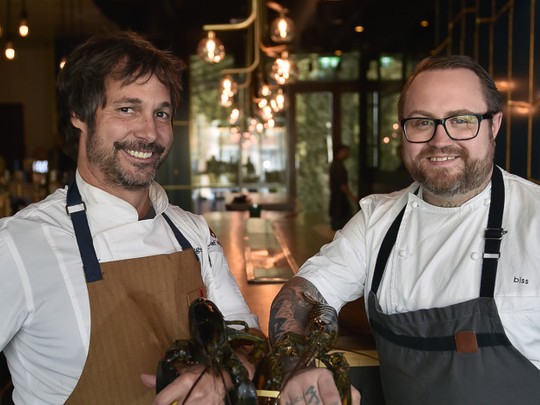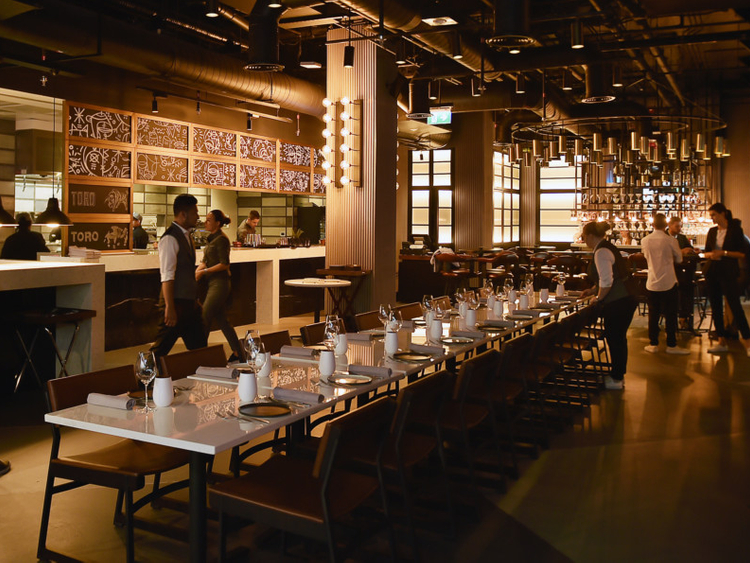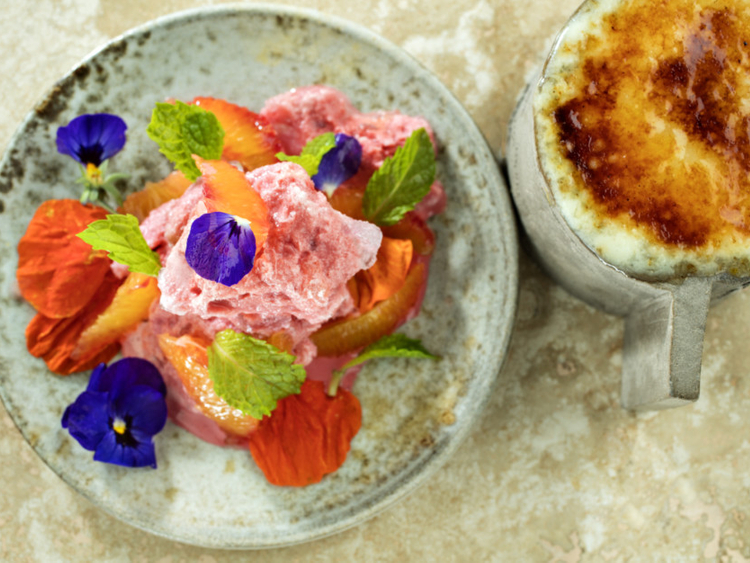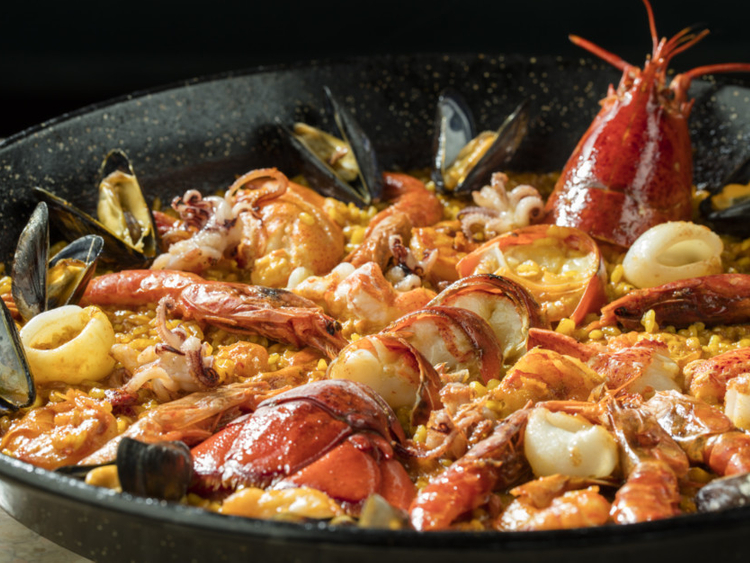
Elbowing Lima for a place in the spotlight down in the secret, licensed area of City Walk Dubai are Ken Oringer and Jamie Bissonnette, whose Toro & Ko is set to open within the next week. The bromancers and James Beard winners run restaurants in Boston, New York and Bangkok together, and are bringing that hip, matey vibe to Dubai following an agreement with mall operators Meraas.
The pair have been working together for more than a decade, first at KO Prime in Boston, a nose-to-tail steakhouse, and subsequently at the Toro and Toro & Ko tapas venues.
Toro & Ko Dubai, which took more than two years to come to fruition, seats 160 people over two levels, indoor and out. We caught the change-of-season bug going around this week, so we didn’t get a chance to stuff our faces, but the menu will bring us back.
Inside the restaurant, the industrial chic of the downstairs area offers a close-up reality-TV view of the kitchen drama created by head chef Oscar Poquet Bigorda and his team. A metal staircase leads upstairs, where tones of cerulean and cocoa play off against each other for a more retro, laid-back vibe, while a long bar and a DJ station compete for smokers’ attention. And for the selfie-inclined, there’s also a secret area with a view of the mall and the Burj Khalifa.
It’s too hot for any of that, so we sink into the leather sofas for a freewheeling chat with the kitchen collaborators. Edited excerpts:
So Toro & Ko Dubai is a Barcelona-style tapas bar?
Oringer: Yes. So higher energy, a little again a little louder than a traditional restaurant and with a lot of plates that can be shared. I mean, we have some family-style things and options for two people. But the more the merrier, you know, in the spirit of Spain, where it’s about enjoying the people you’re with and celebrating the moment.
Bissonnette: Rather than order an entree and a three-course meal, you could potentially have 12 or 15 things to share among your table. It’s like, Choose Your Own Adventure.
But it’s also a US-style Barcelona tapas bar, because you’re both, like American?
Oringer: I think the US bit is that we kind of break some rules sometimes. In Spain, the avant-garde has been encouraged for some time now, ever since El Bulli and restaurants like that, but we also again love the creativity and the renegade style of making our own rules.
OK, but you’re in a busy neighbourhood, so what’s the differentiator?
Oringer: First of all our menu is huge. We have about 60 or so tapas and it ranges from everything from sea urchin with Osscietra caviar and quail egg, to roasted bone marrow with beef cheek marmalade, to our paellas and the charcuterie section, and then there’s lots of seafood and gambas. We don’t like to take ourselves too seriously. We’re just about having fun and taking risks with the food.
Bissonnette: It’s like when you get on stage in a band, it doesn’t matter what band is playing next door, you only care about the stage and the crowd in front of you. If everybody else is a little classical, we’re more avant-garde. We like to riff on things.
So that charcuterie… it’s not pork?
Bissonnette: No. Some of the best charcuterie in the world comes from Spain, but there’s been a huge Muslim culture in Spain for forever. Without the Muslims, there’d be no rice, no paella. And Spain has great halal charcuterie — the salami, salchichon, which is a kind of summer sausage, chorizo, Cecina, which is a great dry-cured beef. Some of this is not even known outside its region.
Oringer: We’re also making our own duck proscuiotto here.
So you’ve eaten around Dubai. What have you tried besides the mutton brains at Ravi’s?
Bissonnette: Those were great. They’re very rich but very delicate. I don’t know that I can eat again in this weather. One of my favourites last time was Bu Qtair — I just loved the fresh fish and the curry and the rice.
Oringer: There’s a Lebanese place we’ve heard about we’re going to. Al Mallah.
How did the two of you get together, go into business?
Bissonnette: So the short story, is that growing up, outside of Hartford, Connecticut, I knew a bunch of people that knew Ken. I was like, I want to be a chef. And they said, talk to Ken. He’s going to be a chef. But these were not guys who had a lot of positive stuff going on in their life so I thought there was zero per cent chance…
Oringer: [interrupting] And I have nothing positive in my life!
Bissonnette: But then I went to culinary school and back and forth from Connecticut to Boston a couple of times, and Ken had just won the James Beard award — so I was trying to get a spot in his restaurant. And my uncle who actually knew Ken, was like, this is the guy everybody’s been telling you about forever. That was an Aha! moment.
Oringer: But the thing that got us together was we would talk food non-stop, every cuisine, every cookbook ever written — it’s very rare to find someone with the same obsession, and I was like, we should do something together. And when KO Prime came up, we just got together.
Bissonnette: It was about the time I told my wife at the time I was looking for something different, and she…
Oringer: She wishes she’d never had that conversation.
Bissonnette: Yeah, she never thought I’d leave her for Ken! (laughs) I think we’re just so similar… you know, it’s like crazy — we’re born two days apart, a decade apart.
Oringer: Obviously Jamie’s older than I am…
So how does it work? Who cooks?
Oringer: You know, I’ll wake up early and go in the kitchen and start something or I’ll shoot him a text. What do you think — I’m putting black line with tripe, and he’ll be right back with suggestions.
Bissonnette: I’ll be like, I’ll meet you in 30 minutes and then we’ll just be cooking. Trying things, or adding in things… We just collaborate pretty much on everything.
Given your love for travel, and the UAE’s demographics, wouldn’t it make more sense to open a Little Donkey here?
Oringer: Little Donkey just turned one actually a couple of weeks ago. Restaurants need to mature a little before you can just kind of like push them off to the side and let them figure out things for themselves. I think Little Donkey needs to keep the training wheels on for a little bit longer.
Bissonette: It’s got a mind of its own, every time we time to turn our backs it’s like trying to steal out of the cookie jar.
So what would you take away from here in terms of food and ideas?
Bissonnette: I can’t remember where it was, but some of the places I ate at with my friend last time the catalyst for some of the dishes that ended up on the menu at Little Donkey. We did a version of a seafood biryani. And eventually we did a recipe based on our experience at Bu Qtair.
Oringer: We have live scallops that we that we grill with muhammara butter….
I want them now. Bring them to Dubai! What do you think is the next big trend? We’ve seen Peruvian, Spanish…
Oringer: I think just Middle Eastern food is what we’re seeing all over the states. Whether it’s Lebanese Syrian… you’re starting to see a lot more because I think Americans are now craving flavour like they do in other parts of the world.
Bissonnette: One of my friends wants me to bring back some awesome black limes and za’atar for his Italian restaurant.
Oringer: Pierre Gagnaire’s been using sumac and ras al hanout in their recipes forever.
So what’s it going to take to break out?
Bissonnette: You know, with this new world of social media, you never know when somebody’s going to sneeze and become the next star. And Middle Eastern food will explode.
Right, so what would you order each other off the menu at Toro & Ko?
Bissonnette: If I was going to order a dish for KO on this menu I would order probably one of the paellas. I know he never gets sick of that. He loves seafood.
Oringer: For this guy, he’s a true down and dirty bone marrow guy, and so definitely the roasted bone marrow with beef cheek marmalade with the citrus salad and radishes. (Looks at Jamie) I know you would just take it take a spoon and the toast and get down and dirty with it.
Bissonnette: If we were doing it together, I would then scrape it into the paella.
____
WHO ARE KEN & JAMIE?
If you haven’t heard of either of these bad boys, consider expanding your culinary knowledge beyond the old countries.
Ken: By the age of six, Jersey boy Ken Oringer knew he wanted to be a chef, inspired by watching Julia Child and encouraged by his parents. The Culinary Institute of America alum trained at the iconic River Café in Brooklyn, as well as with Jean-Georges Vongerichten in Boston, before earning a name for himself with his Asian-inflected food across the continent at Silks in the Mandarin Oriental San Francisco. The Food Network regular launched the French-American concept Clio in 1997, the Japanese street-food Uni, the enoteca Coppa, and the Toro chain that he runs with Jamie. Weird fact? He can’t abide eating eggs, he told Boston.com, although he cooks them.
Jamie, meanwhile, is a recovering vegetarian. Wikipedia, that rock-solid fount of knowledge, tells me he was a Connecticut punk-rock kid, straightedge and vegetarian before he headed into professional kitchens (although he’d worked in delis as a teenager), where at one point his boss threatened to fire him if he didn’t start eating animals. He ended up running the KO Prime steakhouse for Ken and got the words “eat offal” tattooed on his hand, so it’s safe to say he recovered from that fashion) Last year, he was named Massachusetts Executive Chef of the year.
Besides Toro, the duo also partnered to open Little Donkey last year in Cambridge, Massachusetts. Described as a global tapas restaurant, it serves a menu of small plates inspired by travels around the world, as well as by locally available produce.
____
Paella de Marisco recipe
INGREDIENTS
45g Olive oil
60g Calamari sofrito
4 prawns
4 calamari
1 lobster
90g rice
Pinch of saffron
400ml Fish stock
400ml Bisque stock
Calamari sofrito
40g Olive oil
200g Calamari
500g Tomato
2 tsp Salt
2 tsp Sugar
10 cloves garlic
METHOD
1. Heat the olive oil over a medium heat in the paella pan
2. Brown the prawns, a couple of minutes on each side. Place to one side for later.
3. In the same oil, brown the squid. Place to one side for later.
4. To the pan add the red pepper. If necessary add 1 more tablespoon of olive oil. Sauté until tender
5. Add the garlic and continue to sauté the vegetables
6. Slowly add the Calamari Sofirto (traditional tomato mix) and let mixture reduce for approx 5 minutes
7. Add the fish stock and continue to stir
8. Test and add seasoning if necessary
9. Add the strands of saffron, bay leaf and parsley. Adding a sprinkle paprika is optional here
10. Distribute the mussels and the clams for the paella and allow to cook.
11. Pour in the rice and stir the paella to let the rice cook over medium heat. The time is usually indicated pan the package but usually varies between 16 and 20 minutes.
12. Push the cooked squid and prawns into to the paella and stir slowly so that the heat is evenly distributed. (A tip is to shake rather than stir at this point)
13. Once the rice is cooked, cover the paella with a clean kitchen towel and leave stand for 5 to 10 minutes to absorb excess moisture.
14. Serve and enjoy!















